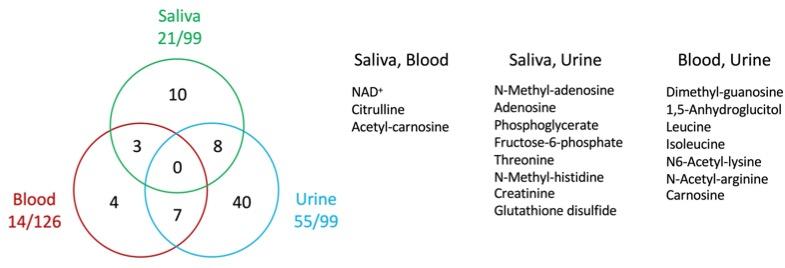Key Points:
· Teruya and colleagues identify 21 age-linked compounds in human saliva.
· Only one metabolite increased in older subjects: ATP, the cell’s energy currency.
· Saliva from older subjects had lower levels of nicotinamide adenine dinucleotide (NAD+), a critical coenzyme.
Throughout the COVID-19 pandemic, many people have monitored their ability to taste, as this symptom has been an indicator of contracting the highly infectious SARS-CoV-2 virus. But have you ever wondered if this unwelcoming effect might be a sign that you’re just getting older? Well, it turns out that the metabolites in our saliva, including those responsible for taste, may serve as promising indicators of cellular aging. Given the large quantity and diversity among salivary metabolites, it is imperative to isolate age-associated metabolites to acquire informative aging data efficiently.
Teruya and colleagues from the Okinawa Institute of Science and Technology (OIST) Graduate University published an article in Scientific Reports that presented the first comprehensive analysis of salivary metabolites linked to aging. Among the 99 identified salivary metabolites obtained from 13 youthful (aged 27-33) and 14 elderly (aged 72-80) volunteers, 21 exhibited age-dependent alterations. Further analysis showed that the young subjects displayed higher concentrations of the 21 identified age-linked metabolites that participate in metabolic pathways responsible for energy production, glucose formation, and protein synthesis. These findings have great potential to predict biological age and elucidate metabolic networks that promote oral diseases upon aging.

“Amongst the metabolites that declined in quantity were two that are related to taste, suggesting that the elderly lose some ability to taste and others that are related to muscle activity, such as swallowing. These age-linked salivary metabolites together illuminate a metabolic network that reflects a decline of oral function during human aging,” commented lead author Dr. Takayuki Teruya in a press release.
How have we monitored biological age so far?
Successfully and accurately predicting one’s true biological age isn’t easy because aging is multifaceted and complex. With age, certain compound levels and patterns of pathway activation change. So, what pieces have we identified from the biological aging estimation puzzle so far?
An initial method for estimating biological age involved assessing blood-based biomarkers. For example, inflammatory molecules, known promoters of age-associated conditions, have served as key indicators of aging in blood. Artificial intelligence (AI) and machine learning, sophisticated computational methods, have been paramount to the evolution of aging technology. The development of epigenetic clocks, tools that quantify biological age through patterns of DNA modifications, would not have been possible without these advancements. However, there are still other viable means of obtaining data to monitor a person’s biological age without using complex computational algorithms based on AI.
One such method is metabolite analysis. Metabolite levels are extremely useful in determining what metabolic pathways are active in aged individuals. Researchers have successfully pinpointed age-linked metabolites in both blood and urine, but Teruya and colleagues are the first to identify age-linked metabolites in saliva.
Salivary Age-Linked Metabolites Decrease in the Elderly
In evaluating the metabolic profiles of saliva, the OIST investigators showed that 21 out of the 99 identified metabolites were age-linked. The statistical analysis concluded that 20 of the age-related compounds exhibited diminished levels among the elderly subjects. One of those compounds happened to be the life-preserving molecule nicotinamide adenine dinucleotide (NAD+).
NAD+ is an essential coenzyme required for all cellular functions and is known to participate heavily in processes responsible for energy production and DNA repair. Studies have shown that lower levels of NAD+ can induce metabolic and age-associated conditions, such as obesity, insulin resistance, and Alzheimer’s disease. Thus, the observed decrease of NAD+ in the saliva of elderly subjects suggests the possible onset of oral metabolic diseases in aged individuals.

A Correlation Network Exists Between Age-Related Metabolites in Saliva
To better understand the correlation between the identified age-linked salivary metabolites, Teruya and colleagues looked at the abundance patterns of these metabolites. Only 14 of the 21 age-related compounds produced significant correlation scores indicative of specific active metabolic pathways in saliva. In addition, the saliva from elderly subjects presented reduced levels of these 14 compounds, further suggesting that specific metabolic pathways are less active in aged individuals and likely contribute to the development of age-related diseases.
Since previous studies that predict aging have used blood and urine, Teruya and colleagues tested whether there was any overlap with the saliva findings. Surprisingly, there were no common age-related metabolites that linked saliva, blood, and urine together. However, saliva and blood shared three, saliva and urine shared eight, and blood and urine shared seven age-linked metabolites. Ten salivary age-linked metabolites were found only in saliva and not in either blood or urine. While these findings highlight the possibility of aging mechanisms working in parallel between saliva, blood, and urine, more research is required to confirm this hypothesis.

(Teruya et al., 2021 | Scientific Reports) Common human age-related metabolites in saliva, blood, and urine. (a) Numbers of shared compounds in overlapping regions. No compound was common in saliva, blood, and urine. Three, 7, and 8 compounds were common between saliva and blood, between blood and urine, and between saliva and urine, respectively. (b) Three, eight, and seven age-linked compounds were commonly found between saliva and blood, saliva and urine, and blood and urine, respectively.

Professor Yanagida concluded, “In saliva, age-linked metabolites are related to relatively broad metabolic conditions so that age-related information obtained from salivary metabolites may be distinct from that of blood and urine. The results of this study may be useful in the future to assess easily the degree of metabolic aging in humans or to find early indications of age-related diseases.”
The Future of Saliva-Based Testing to Monitor Human Health and Disease
Since acquiring saliva samples is simple, straightforward, and affordable, saliva-based testing may be quite popular among individuals who are interested in keeping tabs on their health. Whether the desire is to monitor biological age or identify one’s susceptibility to developing a particular disease, saliva-based testing can illuminate novel metabolic networks that contribute to aging.
“Saliva also has a close connection to mouth health. If a mouth does not function properly, it can make consuming food challenging, which is highly detrimental to one’s quality of life. I hope through this research we can better support elderly people,” stated Professor Mitsuhiro Yanagida, lead researcher at OIST’s G0 Cell Unit, in a press release.